
10 Must-Have Tools for Strong Adhesion in Renovation
Share
When tackling renovation projects, you know that strong adhesion is vital for a successful outcome. To achieve this, you'll need the right tools for the job, including surface preparation essentials like wire brushes and vacuum cleaners, bonding agent applicators with adjustable flow control, and concrete scrubbers and brushes for a solid foundation. Don't forget epoxy resin mixing tools, adhesive dispensing guns, and curing compound applicators for precise application. Add concrete etching equipment, primer application tools, and adhesion testing devices to your arsenal, and you'll be well on your way to ensuring strong adhesion and a durable finish. As you dive deeper into the world of renovation, you'll discover the importance of each tool in achieving a flawless bond.
Key Takeaways
• Effective surface preparation requires tools like wire brushes, scrapers, and vacuum cleaners to remove dirt, old adhesives, and debris.
• Substrate cleaning solutions, such as solvent-based cleaners and mild abrasives, ensure strong adhesion by removing dirt and contaminants.
• Adhesive application tools, like bonding agent applicators and adhesive dispensing guns, must be chosen based on the specific adhesive type and surface material.
• Nozzle design and flow control are crucial in applicator nozzles to achieve precise application and even distribution of adhesives and coatings.
• Adhesion testing devices, such as pull-off testers and surface energy testers, help measure bond strength and identify areas for improvement in renovation projects.
Surface Preparation Essentials
You'll need a solid foundation to secure a successful renovation, and that starts with surface preparation, which relies on several important tools to get the job done efficiently and effectively.
Different surface types require specific preparation techniques to guarantee a strong bond between the old surface and the new material. For instance, concrete surfaces may need to be scarified or shot-blasted to remove laitance and create a rough texture, while wood surfaces may require sanding or grinding to create a smooth finish.
Having the right tools for the job is vital. A wire brush or scraper is ideal for removing dirt, grime, and old adhesives from surfaces. A putty knife or trowel is necessary for applying and smoothing out fillers or patching compounds. A vacuum cleaner or blower is also important for removing dust and debris from the surface.
Bonding Agent Applicators
When selecting a bonding agent applicator, you'll want to take into account the tool's design and functionality to guarantee a successful renovation project.
You'll need to choose an applicator that can effectively dispense the bonding agent, and that's where the nozzle design comes into play.
Tool Selection Matters
Selecting the right bonding agent applicator is essential to guaranteeing a strong, long-lasting bond between the substrate and the new material. You want to choose a tool that's reliable, efficient, and easy to use.
When it comes to tool selection, you should prioritize durability and ergonomic design. A durable applicator can withstand heavy use and harsh environments, while an ergonomic design reduces fatigue and improves control.
Here are some key factors to evaluate when selecting a bonding agent applicator:
-
Material quality: Look for applicators made from high-quality materials that can resist corrosion and wear.
-
Ergonomic grip: A comfortable grip reduces fatigue and improves control, allowing you to work for longer periods without straining your hand.
-
Adjustable flow control: An adjustable flow control feature allows you to customize the application rate to suit your specific needs.
- Easy cleaning and maintenance: A tool that's easy to clean and maintain guarantees you can get back to work quickly and efficiently.
Applicator Nozzle Design
Three key nozzle design elements - orifice size, nozzle angle, and tip material - greatly impact the performance of a bonding agent applicator, allowing you to achieve a uniform coating and a strong bond.
To get the best results, you'll want to choose an applicator with a nozzle size that's optimized for your specific bonding agent. A larger nozzle size can lead to a higher flow rate, but may compromise precision, while a smaller nozzle size provides more control but may increase application time.
The nozzle angle also plays a critical role, as it affects the spray pattern and coverage area. A wider nozzle angle can cover more surface area but may lead to uneven distribution, while a narrower angle provides more precise control but may require more passes.
The nozzle material is equally important, as it can impact the durability and resistance of the applicator. Look for nozzles made from high-quality, chemical-resistant materials that can withstand the bonding agent's properties.
Concrete Scrubbers and Brushes
You'll need concrete scrubbers and brushes to effectively remove dirt, grime, and old coatings from your concrete surfaces before applying new finishes. These tools are essential for ensuring a strong bond between the old surface and the new finish.
When it comes to scrubbers, there are various types to choose from, each designed for specific tasks. For instance, you can opt for a wire scrubber for aggressive cleaning or a nylon scrubber for gentler surfaces.
Here are some key considerations for concrete scrubbers and brushes:
-
Scrubbers with stiff bristles are ideal for removing thick, stubborn coatings and dirt.
-
Soft-bristled scrubbers are better suited for delicate surfaces that require gentle cleaning.
-
Natural fiber brushes, such as those made from coconut or sisal, are effective for cleaning rough concrete surfaces.
- Synthetic brushes, like nylon or polyester, are durable and suitable for cleaning smooth surfaces.
Epoxy Resin Mixing Tools
Mixing epoxy resin requires precision and control, which is where epoxy resin mixing tools come in to guarantee a thorough and bubble-free blend. As you work on your renovation project, you'll need the right tools to secure a strong bond between surfaces.
Epoxy resin mixing tools are designed to help you achieve this by providing an accurate and efficient mixing process. When it comes to epoxy mixing techniques, having the right tools makes all the difference. A good mixing stick or paddle is essential for scraping the sides and bottom of the mixing container, making sure that all components are fully incorporated.
You'll also need a mixing cup or container that's specifically designed for epoxy resin, with a flat bottom and straight sides to prevent air pockets from forming. Additionally, consider investing in a mixing scale or ratio calculator to guarantee accurate proportions of resin and hardener.
This is especially important when working with specific resin curing methods that require precise ratios for the best outcomes. By having the right epoxy resin mixing tools at your disposal, you can achieve a strong, durable bond that will last for years to come.
Adhesive Dispensing Guns
Adhesive dispensing guns provide a controlled and efficient way to apply adhesives, sealants, and lubricants, allowing you to accurately dispense the exact amount needed for your renovation project. When it comes to working with various adhesive types, having the right dispensing gun can make all the difference.
You'll want to take into account the following factors when selecting an adhesive dispensing gun:
-
Compatibility: Verify the gun is compatible with the specific adhesive type you're working with, whether it's epoxy, acrylic, or silicone.
-
Flow control: Look for a gun with adjustable flow control to achieve the perfect bead size and consistency.
-
Ergonomics: Choose a gun with a comfortable grip and ergonomic design to reduce fatigue during extended use.
- Cleaning: Think about a gun with easy cleaning features, such as removable nozzles, to maintain precision and prevent clogs.
Substrate Cleaning Solutions
When you're preparing a surface for renovation, you'll need to guarantee it's free from dirt, grime, and other contaminants that can compromise the bonding process.
You'll want to select a substrate cleaning solution that effectively removes dirt and grime, leaving a clean surface that's ready for the next step.
Effective Dirt Removal
You'll need a reliable substrate cleaning solution to remove dirt, grime, and other contaminants that can compromise the bond between your new surface and the old one. Effective dirt removal is vital for ensuring a strong adhesion in your renovation project.
To achieve this, you can employ various dirt cleaning techniques and surface grime removal methods. Here are some essential tools to include in your arsenal:
-
Solvent-based cleaners: These are effective for removing stubborn grime and oil-based contaminants.
-
Abrasives: Mild abrasives like baking soda or gentle scrubbers can help remove dirt and grime without damaging the surface.
-
Pressure washers: These can be used to blast away heavy dirt and debris, especially on exterior surfaces.
- Microfiber cloths: These gentle cloths are perfect for wiping away dirt and dust without leaving streaks or residue.
Surface Preparation Essentials
With the dirt and grime removed, it's time to focus on the substrate cleaning solutions that will prepare the surface for the new finish.
You'll want to select a solution that effectively cleans the surface without damaging the substrate. Look for solutions that are specifically designed for your substrate type, whether it's concrete, wood, or metal. A thorough surface analysis will help you identify any contaminants or imperfections that need to be addressed before applying the new finish.
When choosing a substrate cleaning solution, contemplate one that provides texture enhancement. This will help create a strong bond between the substrate and the new finish.
You may also want to reflect on a solution that includes a rust inhibitor, especially if you're working with metal substrates. Remember to always follow the manufacturer's instructions for application and drying times to guarantee a successful renovation.
Curing Compound Applicators
How do you guarantee a uniform, even application of curing compounds to fresh concrete surfaces? The answer lies in using the right curing compound applicators. These tools are designed to make sure that curing compounds are applied correctly, maximizing their advantages and promoting strong adhesion in renovation projects.
When it comes to curing techniques, the right applicator can make all the difference. Here are some key features to look for in a curing compound applicator:
-
Adjustable flow control: Allows you to customize the application rate to suit your specific needs.
-
Even pattern distribution: Ensures a uniform coating that covers the entire surface.
-
Easy to clean and maintain: Reduces downtime and extends the life of your equipment.
- Compatibility with various compound types: Gives you flexibility and versatility in your renovation projects.
Concrete Etching Equipment
By incorporating concrete etching equipment into your renovation arsenal, you can effectively prepare surfaces for coatings, paints, or overlays, ensuring a strong bond between the existing concrete and the new material. This vital step enhances the surface texture, allowing for better adhesion and a longer lifespan of the newly applied material. Concrete etching techniques involve using acid-based solutions or mechanical methods to create a rough, porous surface, ideal for bonding.
When selecting concrete etching equipment, consider the type of project and the desired surface texture effects. For example, acid-based etching solutions are suitable for small areas and provide a high level of control, while mechanical etching methods, such as shot blasting or scarifying, are better suited for larger areas and offer faster results.
Regardless of the method, it's important to follow safety guidelines and manufacturer instructions to avoid damaging the concrete or compromising the etching process. By investing in the right concrete etching equipment, you'll be able to achieve a strong, long-lasting bond and a successful renovation project.
Primer Application Tools
When applying primer, you'll need the right tools to get the job done efficiently and effectively.
You're about to learn how to choose the perfect roller extension for your project, ensuring a smooth and even coat.
Additionally, you'll discover the importance of selecting the right brush type to achieve a professional-looking finish.
Roller Extensions Matter
You'll achieve a smoother, more uniform primer application with the right roller extension, as it allows for extended reach and reduced strain on your body.
When it comes to primer application, using the correct roller extension can make all the difference. It enables you to access those hard-to-reach areas, such as high ceilings and corners, with ease. Additionally, it reduces the physical effort required, allowing you to work more efficiently and effectively.
Here are some benefits of using the right roller extension:
-
Improved roller techniques: With an extension, you can maintain the ideal roller angle and apply even pressure, resulting in a smoother finish.
-
Reduced fatigue: By reducing the need for excessive stretching and straining, you can work for longer periods without fatigue.
-
Increased coverage: An extension allows you to cover more surface area with each stroke, making the priming process faster and more efficient.
- Better results: The right extension guarantees consistent primer application, which is essential for strong adhesion and a durable finish.
Brush Selection Tips
During the primer application process, selecting the right brush is essential, as it directly impacts the overall quality of the finish. You'll want to choose a brush that's suitable for your specific project, considering factors like brush material types and brush size selection.
| Brush Material | Best For | Characteristics |
|---|---|---|
| Natural Bristle | Oil-based primers | Absorbs well, holds a lot of paint |
| Synthetic Fiber | Water-based primers | Less absorbent, easier to clean |
| Blended Bristle | Universal primers | Balance of absorbency and ease of cleaning |
| Angled Sash | Trim work, corners | Precise control, angled for tight spaces |
When selecting a brush size, consider the surface area you need to cover. Larger brushes (4-6 inches) are ideal for broad, flat areas, while smaller brushes (1-2 inches) are better suited for trim work and detailed areas. Remember, the right brush can make all the difference in achieving a smooth, even finish. By choosing the right brush for your project, you'll guarantee a strong bond between the primer and your surface, setting yourself up for a successful renovation.
Adhesion Testing Devices
You need adhesion testing devices to determine the bond strength between a coating or adhesive and its substrate, guaranteeing a durable and long-lasting renovation result.
Without these tools, you risk adhesion failure, which can lead to costly rework and project delays.
Adhesion testing devices help you identify potential issues early on, allowing you to make adjustments and guarantee a strong bond.
Some essential adhesion testing devices to take into account include:
-
Pull-off testers: Measure the bond strength between a coating and its substrate.
-
Surface energy testers: Determine the surface tension of a material, affecting its adhesion properties.
-
Adhesion testers with variable angles: Simulate real-world conditions and test adhesion at different angles.
- Adhesion failure analysis software: Analyze test data to identify patterns and areas for improvement.
Frequently Asked Questions
How Do I Choose the Right Adhesive for My Specific Project Needs?
When selecting an adhesive, you'll want to take into account the specific materials involved in your project.
Different adhesive types are suited for various materials, so it's essential to choose the right one.
For example, epoxy adhesives work well with metals and glass, while acrylic adhesives are better suited for plastics and ceramics.
What Safety Precautions Should I Take When Working With Epoxy Resin?
When working with epoxy resin, you should take safety precautions seriously.
First, guarantee good epoxy ventilation in your workspace to avoid inhaling harmful fumes.
Wear resin gloves to protect your skin from irritation and potential allergic reactions.
Additionally, wear safety goggles and a mask to prevent eye and respiratory damage.
Always follow the manufacturer's instructions and mix the resin in a well-ventilated area to minimize risks.
Can I Use a Single Tool for Multiple Surface Preparation Tasks?
When it comes to surface preparation, you're likely wondering if you can get away with using a single tool for multiple tasks.
The answer is yes, you can! Multi-purpose tools are a great investment for any renovation project. They allow you to switch between tasks seamlessly, saving you time and effort.
Look for tools with interchangeable heads or adjustable settings to tackle various surface prep tasks with ease.
How Often Should I Clean and Maintain My Adhesion Tools?
You're probably thinking, 'I've got the best tools, I'm all set!'
But, let's face it, even the most elite tools are useless without proper maintenance.
You need to clean and maintain your adhesion tools regularly to guarantee peak performance.
The cleaning frequency depends on usage, but as a rule of thumb, clean your tools daily and perform deep maintenance every 1-2 weeks.
This will prevent damage, reduce wear, and assure a strong adhesion every time.
Are There Any Environmental Factors That Affect Adhesion Strength?
You need to take into account environmental factors that impact adhesion strength.
Temperature effects, for instance, can greatly alter bonding properties. High temperatures can weaken adhesion, while low temperatures can strengthen it.
Additionally, humidity levels play an essential role, as excessive moisture can compromise the bond.
You'll want to guarantee ideal conditions for your specific adhesive, taking into account the manufacturer's guidelines for temperature and humidity ranges.
Conclusion
You've got the essential tools for strong adhesion in renovation. With these 10 must-haves, you'll guarantee a solid bond between materials.
Did you know that according to the Adhesives and Sealants Council, proper surface preparation can increase the strength of an adhesive bond by up to 50%?
Invest in these tools and take your renovation projects to the next level.
Related Posts
-

Top Tools for DIY Home Renovation Plastering Success
To achieve DIY home renovation plastering success, you'll need a range of essential tools. Start with hand tools like...
-

Trowel Tool Cost for DIY Home Renovation Projects
When it comes to your DIY home renovation project, you'll need to budget for a variety of trowel tools, including stu...
-

What to Look for in Pneumatic Renovation Tools
When selecting pneumatic renovation tools, you'll want to take into account several key factors to guarantee optimal ...


